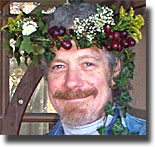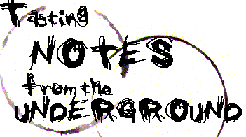|
|
|
|
|
|
|
1995 Ponzi Willamette Pinot Noir Reserve, 13%
alc.: Michael Rowley pulled this rusty ruby garnet gem from his
cellar, not knowing what to expect, and it impressed us all with an
attractive mature character, showing mushroom, a little earth and smoky
plum and black cherry flavors and aromas; it develops a nice note of sea
air on the nose as it opens. Medium to medium full bodied, with mostly
resolved tannins and a lovely sense of balance. This may still get
better with further cellaring, but it’s already quite delightful.
Imported by Vin Divino, Chicago, IL
2003 de Trafford "Straw Wine" Stellenbosch, 14% alc.: As reported previously in these pages, this is called "straw wine" because the Chenin Blanc grapes are carefully laid out on a bed of straw and dried before being pressed, making for a tremendous alternative to Icewine in a region that can't DO Icewine. Dense, intense and unctuous, with seriously sweet essence of honeyed peach and apricot, and buoyed by good acids and some subtle mineral underneath, this promises years of improvement and then more years of holding its own. I didn’t ask how John happened to come by this, because as Joel Goldberg once informed us, it’s “scarcer than hens’ teeth.” I just shut my mouth, closed my eyes and enjoyed it. Find this wine We went back to the well once again in the past few weeks, enjoying five fine bottles from Paul Draper & Co., all old friends and none of them younger than ten years old. There’s something about these wines when they have some age to them that really demonstrates the true beauty of what Ridge is all about. We got things started with a gem that Mr. TNT himself, Tim Thomas, brought along during a late July visit to Day-twah.
1990 Ridge Lytton Springs Zinfandel, 80 % Zinfandel, 10 % Petite Sirah, 6 % Carignane, 4 % Grenache, 13.8 % alc.: Back when this was a current release, and for some time thereafter, it was THE favorite wine of Kim and this taster, period, so it’s always nice to see how it’s coming along, and I’m happy to say that we weren’t disappointed when Bennett Traub brought it and the following selection over to share with us and our daughter Jessica Rose aka Dolphin Girl. Showing a good deal of rust to the ruby garnet color, it gives a big hit of mustiness that quickly evaporates, leaving a lovely, mature Draper perfume over black raspberry, blackberry, a little prune, a hint of old wood, some moderate earthiness underneath it all, a little aquarium with air that Bennett describes as “saline” and a funky little undertone that just adds another nuance to the complexity. Mr. Traub adds that “the plumminess is still there, with a little mint on the back end,” and I wouldn’t disagree. Indeed, there’s still a nice core of fruit here (Kim gets a lot of jam), with a smooth texture, moderate tannins, good density, more than enough acidity and a nice finish. What a treat to renew acquaintances with this sublime, mature, claret-like Zin blend, a true testament to just how well these can age, but then, we already knew that, didn’t we? Find this wine 1990 Ridge Geyserville, 64 % Zinfandel, 18 % Petite Sirah, 18 % Carignan, 13.9% alc: While I usually prefer Geyserville to Lytton Springs, such was never the case with the 1990 vintage, and this rusty garnet reminds me once again why that is. It gives that “Geyserville kind of funk” upfront, described variously as “almost a little brett-y” (Kim), “almost mentholatum camphor” (Bennett) and “funky, earthy plum and prune” (this taster). Somewhat Rhône-ish in personality, it shows a lot of leather, some Draper perfume in the background and what Bennett describes as some “strange medicinal qualities” that I failed to detect. Smooth, mellow and somewhat claret-like, it may or may not be a little past its peak, but it’s still enjoyable and interesting as heck. Find this wine 1995 Ridge Geyserville, 62% Zinfandel, 18% Petite Sirah, 15% Carignane, 5% Mataro, 14.2% alc.: Slightly rusty dark garnet color, with some initial barnyard on the nose that fades to allow the fine Draper perfume to come forward, complementing the black raspberry / zinberry aromatics, all of which follow through in the flavors with some earth and dust. The big youthful fruit and structure that this showed for so long have finally achieved some harmony; no, the fruit doesn’t have the vibrancy of youth that it once did, but when it did, the tannins were formidable. Still, it’s thick and dense, with some tannins to burn, and yet it’s like velvet in the mouth, with that claret-like character that these develop with age, this is one more fine example of what mature Mr. Ridge is all about, and yes, it shows a real sense of place. A wonderful synthesis of everything that makes Geyserville one of the great wines of the world when it’s at its best; beyond anything mere tasting notes can convey, real wine, beautiful wine. Find this wine 1996 Ridge Geyserville, 75% Zinfandel, 17% Carignan, 6% Petite Sirah, 2% Mataro, 14.9% alc.: Tasted directly after the ’90 Geezer, this shows the obligatory dark garnet color, with big, earthy Rhône-ish blackberry, black raspberry, mulberry and black plum flavors and aromas; I failed to note who commented that it’s “exactly like the ’90, just more of everything,” but that taster made a good point. There are still significant tannins here, with a huge core of fruit, and it’s quite different from the last time we tasted it. Half an hour’s air helps it open nicely, but this is still a relatively young wine, still in an intermediate stage, needing at least a few more years to really start to show its best. That’s OK, we have more of these, so we’ll wait a while and report back later. Find this wine Reporting from Day-twah, Bastardo
Other Recent Wine Explorations Wines of Domaine Berthet-Rayne
Back to the Underground
Index
|
|



 19
19 19
19 20
20 19
19 19
19